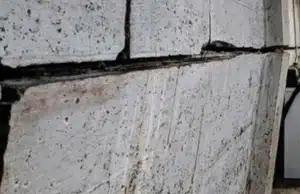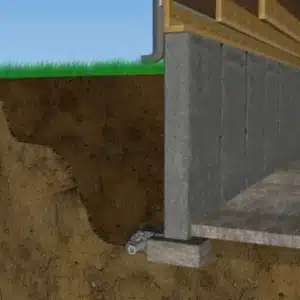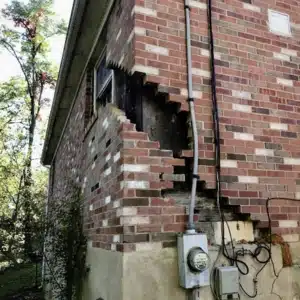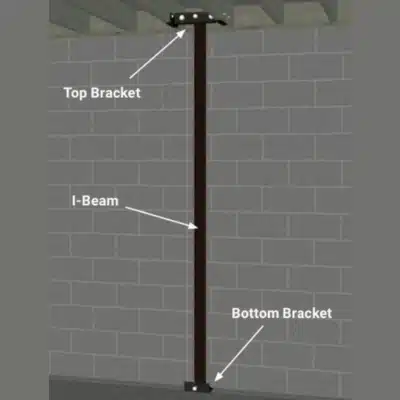Bowing Walls
The presence of bowing walls inside your home indicates external pressure exerted on the walls, which can lead to cracks, instability, and bulging.

Bowing Wall Repair in Northern Virginia, Shenandoah Valley, North Central Virginia, and West Virginia
Bowing walls can be a sign of severe foundation problems, but detecting them can be challenging. The foundation walls tend to move inward due to the constant pressure from expansive soils and hydrostatic pressure. This pressure typically appears as cracks at first but exerts a force on the foundation, crawl space, or basement walls that leads to bowing, buckling, or bulging inward.
Bowed walls indicate significant structural issues that require immediate attention. They worsen the pressure imbalance and can aggravate the initial problem if left untreated.
If you detect bowing in your walls, it’s crucial to seek the expertise of professionals at LUX Foundation Solutions. Our reliable team has the necessary skills and knowledge to repair and stabilize your bowed walls effectively. Contact us to learn more. We proudly serve homeowners in Northern Virginia, Shenandoah Valley, North Central Virginia, West Virginia, and surrounding areas.
Do These Signs of Bowing Walls Seem Familiar?
The symptoms
If you suspect wall bowing on your property, watch out for the following signs:
- Visible horizontal, diagonal, or stair-step cracks on the walls.
- Uneven or sloping floors.
- Doors and windows that stick or no longer close properly.
- Gaps between walls and ceilings.
- Walls leaning at the top or sliding in at the bottom, especially in the basement.
- Water seepage or moisture issues in the affected areas.

Stair-step cracks

Water seepage

Wall leaning

Visible gaps

Uneven floors

Doors sticking
What Causes Bowing Walls?
To find the most suitable and lasting solution for repairing bowing walls in your basement, crawl space, or foundation, it is crucial first to determine the underlying cause. Identifying the root cause of foundation damage can effectively determine long-lasting solutions.
Bowed walls can result from various issues, such as:

Hydrostatic Pressure
Hydrostatic pressure occurs when the soil around your foundation accumulates water, causing the heavy soil to exert pressure against your foundation. This may lead to bowed walls and, eventually, cracks, even if your foundation was constructed using the finest materials. If you find that the land around your house is hard, dense, and pressurized, that might signal a bowing foundation wall due to hydrostatic pressure and standing water.

Expansive Soils
Both Virginia and West Virginia have clay soils. Clay soils are known for being “expansive,” meaning they don’t filter water easily and therefore become quickly saturated. When water is absorbed, the clay soil can expand by 10% or more. This phenomenon can put immense pressure on foundation walls, causing them to bow and crack and ultimately destabilize your home’s foundation.

Structural Instability
Bowing walls might indicate that the structural supports in your foundation are misaligned. The causes of buckling walls may vary, with basement walls leaning in one direction or the other instead of bulging inward. In either case, the risks of bowed walls are consistent. Even if the root cause behind is different, damage to the structural supports of your foundation can result in changes over time. Since these supports are critical to your home’s stability, shifting them could be expensive and hazardous.

Excess Moisture and Oversaturation
Improper exterior drainage, as well as malfunctioning gutters and downspouts, can cause the soil around your foundation to become oversaturated. This oversaturation leads to hydrostatic pressure, which can damage your foundation walls, cause them to buckle and bow, and result in water damage and leaks in your basement.
Our Solutions
LUX Foundation Solutions offers two solutions to secure a bowed wall depending on the severity of the bowing. If the bowing is 2 inches or less, carbon fiber is the best solution. This method involves installing strips of material along the bowed wall, which can provide strength and durability to the structure. Carbon fiber is an excellent choice as it is strong, lightweight, and does not corrode or expand and contract with temperature changes.
However, wall anchors are the best solution if the bowing is more than 2 inches and there are 10 feet of clear access around the affected area. Wall anchors work by drilling holes into the affected wall and attaching metal plates to the interior and exterior sides. The plates are then connected by a steel rod, gradually tightening and pulling the wall back into place. This solution is effective in correcting more severe bowing and preventing further damage.
When dealing with a bowed wall and limited surrounding space, I-beams provide an effective solution. I-beams are ideal for this situation because they can be installed vertically, allowing for minimal disruption in tight spaces. Attaching the I-beams to the wall and connecting them to the foundation or load-bearing structure provides the necessary reinforcement to straighten the bowed wall. The vertical installation of I-beams is advantageous as it maximizes the use of limited space while still offering the structural support needed to rectify the bowing issue.
Contact LUX Foundation Solutions for Reliable Bowing Wall Repair
We understand firsthand how hot, humid summers, mild, rainy winters, and problematic soil can affect the foundation. If you’ve noticed any bowing walls in your foundation, don’t hesitate to reach out to LUX Foundation Solutions.
Our team of experts will thoroughly inspect your property for foundation problems and provide knowledgeable solutions. We’re well-equipped with engineered products to serve foundation repair services in Northern Virginia, Shenandoah Valley, North Central Virginia, West Virginia, and surrounding areas.
Don’t wait until it’s too late! Contact us today at 540-508-8982 or fill out our online free estimate request form to schedule a free, on-site foundation estimate and get expert advice on addressing the issues effectively.
Request a free Estimate
FAQ's
If you notice wall bowing in your home, it is crucial to address the issue promptly. Bowing walls can indicate structural instability and pose serious risks if left unattended. Signs such as cracks in the walls, water seepage, leaning or bulging, and difficulty closing doors or windows indicate bowed walls. Consulting a professional structural engineer or a foundation repair specialist is essential to assess the severity of the situation and recommend appropriate solutions to stabilize and reinforce the walls, ensuring the safety and longevity of your home.
Yes, fixing a bowing wall without replacing the entire foundation is possible. Various methods are available for repairing bowing walls, depending on the severity of the issue, such as:
- Installing wall anchors or braces, which are steel supports attached to the wall’s interior or exterior, to stabilize and straighten it.
- Carbon fiber reinforcement, where high-strength carbon fiber strips are applied to the wall to strengthen it.
- Steel I-beams, where beams are inserted horizontally into the wall and anchored to the floor and ceiling joists to provide additional support and prevent further bowing.
- Helical tiebacks, wherein the method is drilling small holes into the affected wall and inserting helical anchors that extend into the surrounding soil.
These solutions can effectively address bowing walls without needing foundation replacement, saving time and cost. However, it’s essential to consult a professional like LUX Foundation Solutions to determine the most suitable method for your specific situation.
Yes, Virginia’s climate changes and soil conditions can contribute to bowing walls. Virginia experiences various weather conditions, including periods of heavy rainfall and freezing temperatures. Excessive moisture can saturate the soil surrounding the foundation, leading to soil expansion and increased hydrostatic pressure against the walls.
Additionally, the presence of expansive clay soils common in some regions of Virginia can further exacerbate the problem by causing soil movement and uneven pressure on the walls. These environmental factors can contribute to the bowing and instability of walls in Virginia homes. Regular monitoring, proper drainage, and appropriate foundation reinforcement techniques can help mitigate these issues.
When a wall is bowed, it means it is no longer straight and it is curving inward or outward. This can happen for various reasons, such as soil expansion, hydrostatic pressure, excessive moisture, poor drainage, inadequate foundation support, and improper or poor construction practices. If left untreated, it can lead to severe structural damage to your home.
To prevent further damage, it is necessary to seek the help of an expert foundation repair service that can diagnose the root cause of the problem and provide appropriate solutions like wall anchors, carbon fiber straps, or steel I-beams. Don’t ignore the signs of a bowed wall, and consult with a professional before it’s too late.



